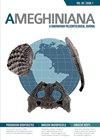Neogene Bony Fishes from the Bahía Inglesa Formation, Northern Chile
IF 1.5
4区 地球科学
Q3 PALEONTOLOGY
引用次数: 4
Abstract
Abstract. Despite being one of the richest Neogene deposits of marine fossil vertebrates along the Pacific coast of South America, no detailed study of bony fishes from the Bahía Inglesa Formation has been carried out. Through the revision of historical collections of the Caldera Paleontological Museum, we describe 27 fossil remains of bony fishes. Fossils described here are distributed in 13 taxa. Among these, Sardinops sp. cf. S. sagax (Clupeidae) represents the first fossil record of the genus for Chile, Labrodon sp. (Labridae) and Stelliferinae (Sciaenidae) are the first respective records for the southeast Pacific Ocean, Sarda sp. (Scombridae) represents the first fossil record for South America, Semicossyphus sp. (Labridae) and Anisotremus sp. (Haemulidae) are the first respective records for the Southern Hemisphere. Gymnosarda sp. (Scombridae) is described for the first time for the Neogene. We performed a paleobathymetric analysis of fossil fishes, including elasmobranchs, to understand the paleoenvironment followed by a similarity analysis that compares the faunal composition of the Bahía Inglesa Fm. with other fossil assemblages for the Pacific of South America. Our results show that the fish fauna from the Bahía Inglesa Fm. likely represents a depth range of 98 to 382 m with a mean depth range of 252 m in an uppermost bathyal environment. The assemblage from the Bahía Inglesa Fm. shows low taxonomic similarity levels with other Neogene geological units from the southeast Pacific Ocean. The study represents the first paleoecological and paleobiogeographic analysis of the fossil fish fauna from the Southeast Pacific.智利北部Bahía Inglesa组的新近纪硬骨鱼
摘要尽管是南美洲太平洋沿岸最丰富的新近纪海洋脊椎动物化石矿床之一,但尚未对巴哈伊-英格莱萨组的硬骨鱼类进行详细研究。通过对卡尔德拉古生物博物馆历史藏品的修订,我们描述了27具硬骨鱼类化石。这里描述的化石分布在13个分类群中。其中,Sardinos sp.。S.sagax(Clupeidae)代表智利的第一个属化石记录,Labrodon sp.(Labridae)和Stelliferinae(Sciaenidae)分别是东南太平洋的第一个记录,Sarda sp.(Scombridae)代表南美洲的第一个化石记录,Semicosyphus sp.(Labridae)和Anisotremus sp.(Haemolidae)分别是南半球的第一个记录。Gymnosarda sp.(Scombridae)首次被描述为第三纪。我们对包括蓝鳃类在内的鱼类化石进行了古水深分析,以了解古环境,然后进行了相似性分析,将巴哈-英格莱萨组的动物群组成与南美洲太平洋的其他化石组合进行了比较。我们的研究结果表明,Bahía Inglesa Fm的鱼类区系在最上层深海环境中的深度范围可能为98至382米,平均深度范围为252米。Bahía Inglesa组的组合与东南太平洋的其他新近纪地质单元在分类学上的相似性较低。这项研究首次对东南太平洋的鱼类化石进行了古生态和古生物地理学分析。
本文章由计算机程序翻译,如有差异,请以英文原文为准。
求助全文
约1分钟内获得全文
求助全文
来源期刊

Ameghiniana
地学-古生物学
CiteScore
2.50
自引率
10.00%
发文量
21
期刊介绍:
Ameghiniana is a bimonthly journal that publishes original contributions on all disciplines related to paleontology, with a special focus on the paleontology of Gondwana and the biotic history of the southern hemisphere. Published yearly since 1957, it has undoubtedly become the main palaeontological publication from Latin America. Ameghiniana has recently broadened its editorial board, reorganized its production process, and increased to a bimonthly frequency, which resulted in a significant decrease in the turn around time.
 求助内容:
求助内容: 应助结果提醒方式:
应助结果提醒方式:


